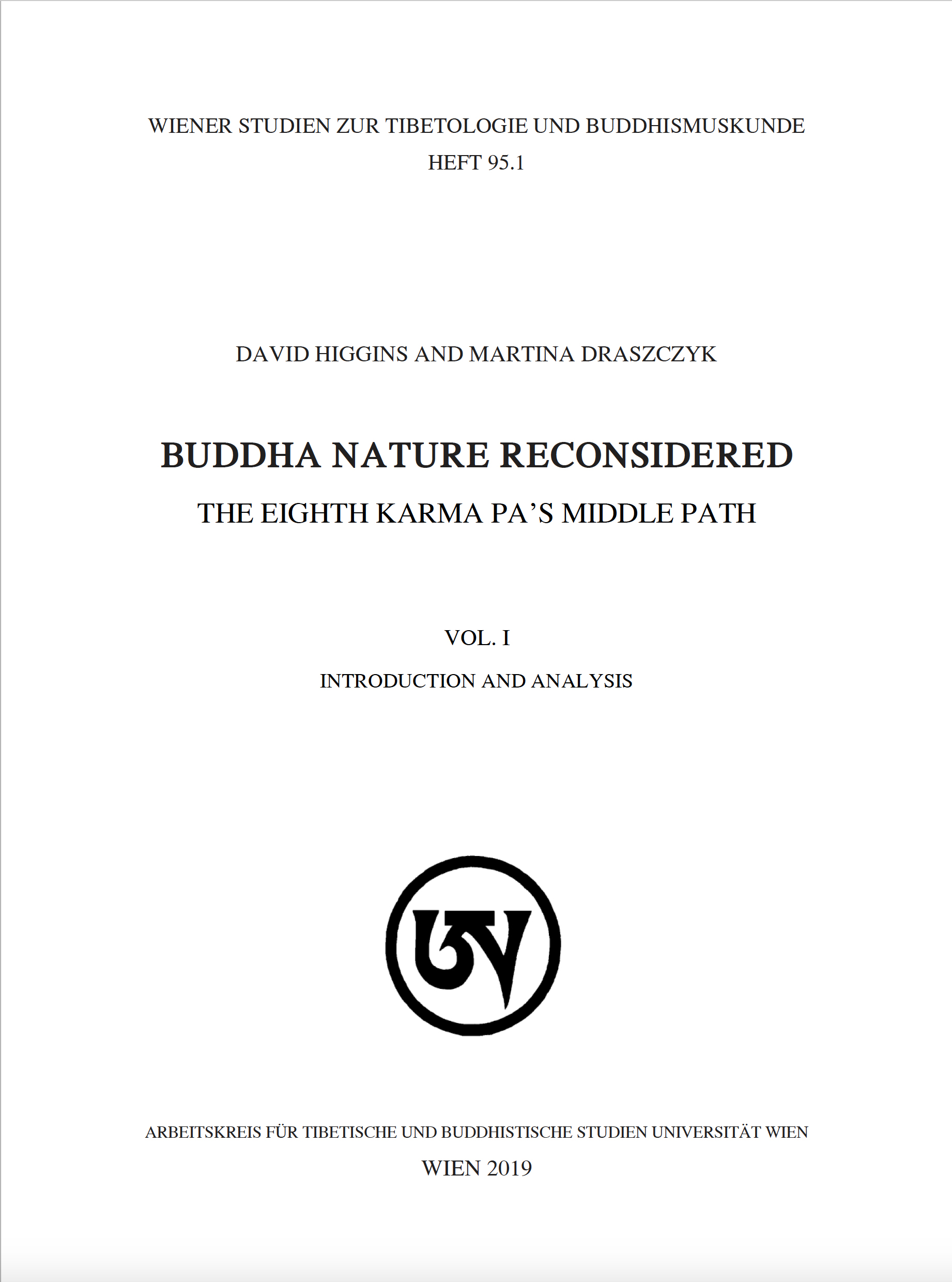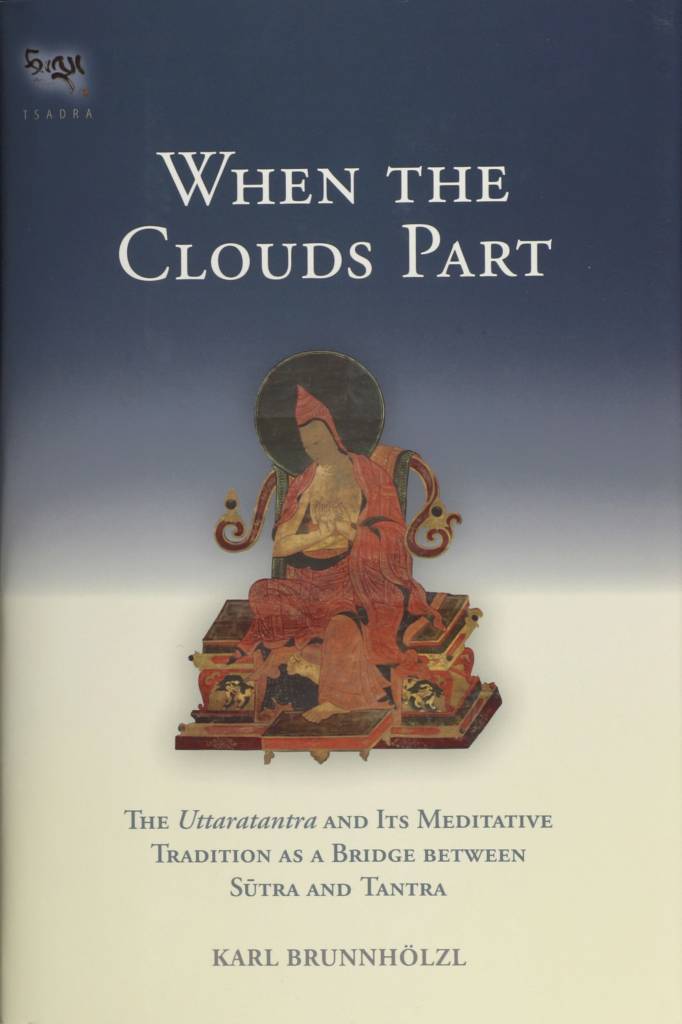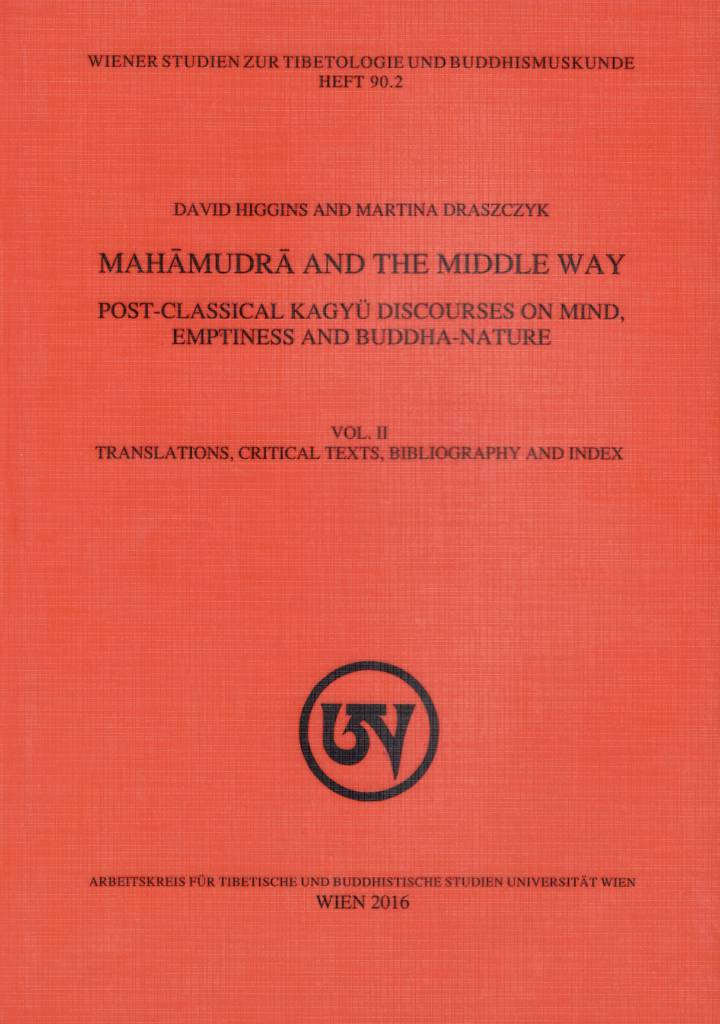Difference between revisions of "Other-Emptiness and the Great Middle Way"
| Line 3: | Line 3: | ||
|image= | |image= | ||
|imagePosition=left | |imagePosition=left | ||
| − | |description=There is no monolithic Shentong School but a great variety of ways in which different Tibetan masters understand this term and how they formulate the associated view. A text by the twentieth-century Kagyü scholar Surmang Padma Namgyal (Zur mang pad ma rnam rgyal n.d., 60.3–61.6) lists seven different kinds of views held by various Jonang, Sakya, Kagyü, and Nyingma masters on the distinction between rangtong and shentong (I am indebted to Anne Burchardi for drawing my attention to this text and providing me with a copy of it). According to this text, (1) Dölpopa and his followers hold consciousness to be rangtong and wisdom to be shentong. (2) Śākya Chogden considers phenomena—appearances—as rangtong and the nature of phenomena—luminosity—as shentong. (3) Sabsang Mati Paṇchen maintains subject and object to be rangtong and expanse (dbyings) and wisdom to be shentong. (4) The Thirteenth Karmapa considers saṃsāra to be rangtong and nirvāṇa to be shentong. (5) The Eighth Karmapa and his followers take the pure kāyas and wisdom to be rangtong in terms of their actual mode of being and to be shentong in terms of the way they appear. (6) The Eighth Situpa considers the side of negation as rangtong and the side of affirmation as shentong. (7) The Nyingma master Gédsé Paṇchen from Gaḥto Monastery (Tib. Kaḥ thog dge rtse paṇ chen, 1761–1829) regards the phase of conclusive resolve during meditative equipoise to be rangtong and the phase of clearly distinguishing during subsequent attainment to be shentong. Among these seven views, Padma Namgyal explicitly considers views (4), (6), and (7) to be good positions. | + | |description=There is no monolithic Shentong School but a great variety of ways in which different Tibetan masters understand this term and how they formulate the associated view. A text by the twentieth-century Kagyü scholar Surmang Padma Namgyal (Zur mang pad ma rnam rgyal n.d., 60.3–61.6) lists seven different kinds of views held by various Jonang, Sakya, Kagyü, and Nyingma masters on the distinction between rangtong and shentong (I am indebted to Anne Burchardi for drawing my attention to this text and providing me with a copy of it). According to this text, (1) Dölpopa and his followers hold consciousness to be rangtong and wisdom to be shentong. (2) Śākya Chogden considers phenomena—appearances—as rangtong and the nature of phenomena—luminosity—as shentong. (3) Sabsang Mati Paṇchen maintains subject and object to be rangtong and expanse (dbyings) and wisdom to be shentong. (4) The Thirteenth Karmapa considers saṃsāra to be rangtong and nirvāṇa to be shentong. (5) The Eighth Karmapa and his followers take the pure kāyas and wisdom to be rangtong in terms of their actual mode of being and to be shentong in terms of the way they appear. (6) The Eighth Situpa considers the side of negation as rangtong and the side of affirmation as shentong. (7) The Nyingma master Gédsé Paṇchen from Gaḥto Monastery (Tib. Kaḥ thog dge rtse paṇ chen, 1761–1829) regards the phase of conclusive resolve during meditative equipoise to be rangtong and the phase of clearly distinguishing during subsequent attainment to be shentong. Among these seven views, Padma Namgyal explicitly considers views (4), (6), and (7) to be good positions. |
| + | - Karl Brunnhölzl, When the Clouds Part, p. 1018, nt. 532. | ||
<div class="text-right zoom-80"> | <div class="text-right zoom-80"> | ||
| Line 48: | Line 49: | ||
<h2>Kagyu</h2> | <h2>Kagyu</h2> | ||
| − | {{CommentatorSeparator| | + | {{CommentatorSeparator|Third Karmapa Rangjung Dorje}} |
| − | + | {{Blockquote | |
| − | |In his | + | |In his The Treatise on Pointing Out the Tathāgata Heart, the Third Karmapa states:</em> |
| − | : | + | ::།ཐ་མལ་ཤེས་པ་དེ་ཉིད་ལ།<br>།ཆོས་དབྱིངས་རྒྱལ་བའི་སྙིང་པོ་ཟེར།<br>།བཟང་དུ་འཕགས་པས་བཏང་བ་མེད།<br>།ངན་དུ་སེམས་ཅན་གྱིས་མ་བཏང་།<br>།ཐ་སྙད་དུ་མ་བརྗོད་མོད་ཀྱང།<br>།རྗོད་པས་དེ་ཡི་དོན་མི་ཤེས།<br> |
| − | :<em> | + | ::<em>Just this ordinary mind<br>Is called "dharmadhātu" and "Heart of the victors."<br>It is neither to be improved by the noble ones<br>Nor made worse by sentient beings.<br>It may no doubt be expressed through many conventional terms,<br>But its actual reality is not understood through expressions. |
| − | | | + | |rang byung rdo rje, (Karmapa, 3rd). de bzhin gshegs pa'i snying po bstan pa'i bstan bcos. In gsung 'bum rang byung rdo rje. Zi ling: mtshur phu mkhan po lo yag bkra shis, 2006: Vol. 7, p. 285.<br>-Translation from Karmapa, The Third, Rang byung rdo rje. ''Luminous Heart: The Third Karmapa on Consciousness, Wisdom, and Buddha Nature''. Translated by Karl Brunnhölzl. Nitartha Institute Series. Ithaca, NY: Snow Lion Publications, 2009: pp. 354-355. |
|style=max-width: none; | |style=max-width: none; | ||
}} | }} | ||
| + | <h2>Sakya</h2> | ||
| + | |||
| + | {{CommentatorSeparator|Śākya Chokden}} | ||
| + | {{Blockquote | ||
| + | |In the opening lines of his Undermining the Haughtiness of Others by the Wheel of Brahma: A Treatise Clarifying Mahāmudrā Śākya Chokden states:</em> | ||
| + | ::རང་བཞིན་རྣམ་དག་རྫོགས་སངས་རྒྱས་ཀྱི་བློ།<br>།གློ་བུར་དྲི་མའི་ཚོགས་དང་མ་འདྲེས་པ།<br>།དུས་རྣམས་རྟག་ཏུ་ཀུན་ལ་བཞུགས་གྱུར་པ།<br>།གཡོ་མེད་ཕྱག་རྒྱ་ཆེ་ལ་ཕྱག་འཚལ་ནས། | ||
| + | ::<em>I pay homage to the unwavering mahāmudrā,<br>The naturally pure perfect buddha-mind—<br>Unadulterated by the host of adventitious stains—<br>That has been ever-present in all for all time. | ||
| + | |shAkya mchog ldan. phyag rgya chen po gsal bar byed pa'i bstan bcos tshangs pa'i 'khor los gzhan blo'i dregs pa nyams byed. In gser mdog paN chen shAkya mchog ldan gyi gsung 'bum. rdzong sar: rdzong sar khams bye'i slob gling thub bstan dar rgyas gling, 2006-2007: Vol. 17, p. 438.<br>-Higgins, David and Martina Draszczyk. ''Mahāmudrā and the Middle Way: Post-Classical Kagyü Discourses on Mind, Emptiness and Buddha-Nature''. Volume 2: Translations, Critical Texts, Bibliography and Index. Wiener Studien zur Tibetologie und Buddhismuskunde 90. Vienna: Arbeitskreis für Tibetische und Buddhistische Studien Universität Wien, 2016: p. 14. | ||
| + | |style=max-width: none; | ||
| + | }} | ||
<h2>Nyingma</h2> | <h2>Nyingma</h2> | ||
Revision as of 13:48, 13 August 2019
- Karl Brunnhölzl, When the Clouds Part, p. 1018, nt. 532.
Watch & Learn
In English with his direct, characteristic humor, Khenpo Rinpoche presents the "shining star" of buddha-nature in the minds of sentient beings as the same nature as the buddhas. He says, "We are always guided by this nature all the time whether we realize it or not."
Jonang
Dölpopa Sherab Gyaltsen
As a basic definition, Dölpopa states:
- དེ་ལ་ཀུན་རྫོབ་གློ་བུར་བའི་དངོས་པོ་རྣམས་ནི་གནས་ལུགས་ལ་གཏན་ནས་མེད་པའི་ཕྱིར་རང་གི་ངོ་བོས་སྟོང་སྟེ་དེ་ནི་རང་སྟོང་ངོ་། ཀུན་རྫོབ་དེ་རྣམས་ཀྱིས་སྟོང་པའི་དོན་དམ་སྟོང་པའི་དོན་དམ་གཉུག་མ་ནི་ནམ་ལང་མེད་པ་མ་ཡིན་པའི་ཕྱིར་གཞན་སྟོང་ངོ་།
- Since adventitious, relative entities do not exist at all in reality, they are empty of their own essences; they are self-empty. The innate ultimate, which is the ultimate emptiness of these relative things, is never non-existent; therefore, it is other-empty.
~ Dölpopa Sherab Gyaltsen, Collected Works ('Dzamthang ed., 1998), Vol. 6: 416.
-Translated by Douglas Duckworth in "Onto-theology and Emptiness: The Nature of Buddha-Nature." (2014), page 1075.
Kagyu
Third Karmapa Rangjung Dorje
In his The Treatise on Pointing Out the Tathāgata Heart, the Third Karmapa states:
- །ཐ་མལ་ཤེས་པ་དེ་ཉིད་ལ།
།ཆོས་དབྱིངས་རྒྱལ་བའི་སྙིང་པོ་ཟེར།
།བཟང་དུ་འཕགས་པས་བཏང་བ་མེད།
།ངན་དུ་སེམས་ཅན་གྱིས་མ་བཏང་།
།ཐ་སྙད་དུ་མ་བརྗོད་མོད་ཀྱང།
།རྗོད་པས་དེ་ཡི་དོན་མི་ཤེས།- Just this ordinary mind
Is called "dharmadhātu" and "Heart of the victors."
It is neither to be improved by the noble ones
Nor made worse by sentient beings.
It may no doubt be expressed through many conventional terms,
But its actual reality is not understood through expressions.~ rang byung rdo rje, (Karmapa, 3rd). de bzhin gshegs pa'i snying po bstan pa'i bstan bcos. In gsung 'bum rang byung rdo rje. Zi ling: mtshur phu mkhan po lo yag bkra shis, 2006: Vol. 7, p. 285.
-Translation from Karmapa, The Third, Rang byung rdo rje. Luminous Heart: The Third Karmapa on Consciousness, Wisdom, and Buddha Nature. Translated by Karl Brunnhölzl. Nitartha Institute Series. Ithaca, NY: Snow Lion Publications, 2009: pp. 354-355.
Sakya
Śākya Chokden
In the opening lines of his Undermining the Haughtiness of Others by the Wheel of Brahma: A Treatise Clarifying Mahāmudrā Śākya Chokden states:
- རང་བཞིན་རྣམ་དག་རྫོགས་སངས་རྒྱས་ཀྱི་བློ།
།གློ་བུར་དྲི་མའི་ཚོགས་དང་མ་འདྲེས་པ།
།དུས་རྣམས་རྟག་ཏུ་ཀུན་ལ་བཞུགས་གྱུར་པ།
།གཡོ་མེད་ཕྱག་རྒྱ་ཆེ་ལ་ཕྱག་འཚལ་ནས།- I pay homage to the unwavering mahāmudrā,
The naturally pure perfect buddha-mind—
Unadulterated by the host of adventitious stains—
That has been ever-present in all for all time.~ shAkya mchog ldan. phyag rgya chen po gsal bar byed pa'i bstan bcos tshangs pa'i 'khor los gzhan blo'i dregs pa nyams byed. In gser mdog paN chen shAkya mchog ldan gyi gsung 'bum. rdzong sar: rdzong sar khams bye'i slob gling thub bstan dar rgyas gling, 2006-2007: Vol. 17, p. 438.
-Higgins, David and Martina Draszczyk. Mahāmudrā and the Middle Way: Post-Classical Kagyü Discourses on Mind, Emptiness and Buddha-Nature. Volume 2: Translations, Critical Texts, Bibliography and Index. Wiener Studien zur Tibetologie und Buddhismuskunde 90. Vienna: Arbeitskreis für Tibetische und Buddhistische Studien Universität Wien, 2016: p. 14.
Nyingma
In his Naturally Liberating Whatever You Meet: Instructions to Guide You on the Profound Path, Khenpo Gangshar states:
- འདི་སེམས་ཅན་ཐམས་ཅད་ཀྱི་སེམས་ཀྱི་རང་བཞིན། དུས་གསུམ་སངས་རྒྱས་ཀྱི་དགོངས་པ། ཆོས་སྒོ་བརྒྱད་ཁྲི་བཞི་སྟོང་གི་སྙིང་པོ། འདྲེན་མཆོག་དཔལ་ལྡན་བླ་མའི་ཐུགས། བཀའ་བར་པ་ནས་ཤེར་ཕྱིན་དང་འཁོར་ལོ་ཐ་མ་ནས་བདེ་གཤེགས་སྙིང་པོ། སྔགས་ཐུན་མོང་བའི་སྐབས་སུ། གཞི་རྒྱུད་རང་བཞིན་ལྷུན་གྱིས་གྲུབ་པའི་དཀྱིལ་འཁོར་
- The mind-essence is the nature of all sentient beings, the realization of the buddhas of the three times, the essence of the eighty-four thousand Dharma-doors and the heart of the glorious master, the supreme guide. It is the transcendent knowledge of the second set of teachings and the sugata-essence of the last turning of the wheel of the Dharma. According to the general system of mantra it is called continuity of ground, the spontaneously present mandala of the innate nature.
~ Mkhan po gang shar. zab lam khrid kyi man ngag 'phrad tshad rang grol. In gsung 'bum gang shar dbang po. Kathmandu: thrangu tashi choling, 2008: p. 121.
-Translation from Thrangu Rinpoche. Vivid Awareness: The Mind Instructions of Khenpo Gangshar. Translated by David Karma Choephel. Boston: Shambhala Publications, 2011: p. 226.
Further Readings
[When the Clouds Part]
As stated before, texts such as CMW, those by Mönlam Tsültrim, GC, the Eighth Karmapa’s Lamp, and GISM all establish connections between the Uttaratantra and Mahāmudrā. Such connections are also found in a number of Indian and Tibetan Mahāmudrā works. Usually, these connections are made in the wider context of the Mahāmudrā approaches that came to be called "sūtra Mahāmudrā" or "essence Mahāmudrā" (the Mahāmudrā approach that is beyond "sūtra Mahāmudrā" and "tantra Mahāmudrā"). In order to provide some background against which the Uttaratantra-based Mahāmudrā instructions in the above texts can be appreciated more fully, I will next present an overview of the key elements of the different approaches to Mahāmudrā, their origins, their scriptural sources, and the different ways in which they are taught.
[Mahāmudrā and the Middle Way]
This two-volume publication explores the complex philosophy of Mahāmudrā that developed in Tibetan Dwags po Bka’ brgyud traditions between the 15th and 16th centuries CE. It examines the attempts to articulate and defend Bka’ brgyud views and practices by four leading post-classical thinkers: (1) Shākya mchog ldan (1423‒1507), a celebrated yet controversial Sa skya scholar who developed a strong affiliation with the Karma Bka’ brgyud Mahāmudrā tradition in the last half of his life, (2) Karma phrin las Phyogs las rnam rgyal (1456‒1539), a renowned Karma Bka’ brgyud scholar-yogin and tutor to the Eighth Karma pa, (3) the Eighth Karma pa himself, Mi bskyod rdo rje (1507‒1554), who was among the most erudite and influential scholar-hierarchs of his generation, (4) and Padma dkar po (1527‒1592), Fourth ’Brug chen of the ’Brug pa Bka’ brgyud lineage who is generally acknowledged as its greatest scholar and systematizer.
[[|Book: Buddha Nature Reconsidered]]

As a Mahāmudrā proponent, Mi bskyod rdo rje gives primacy to innate modes of being and awareness, such as coemergent wisdom or buddha nature naturally endowed with qualities, that are amenable only to direct yogic perception and revealed through the personal guidance of a qualified teacher. As an exponent of yuganaddha (zung ’jug), i.e., unity (literally, “yoking together”), he espouses the tantric goal of unity beyond extremes, a goal grounded in the inseparability of the two truths or realities (bden gnyis dbyer med), of appearance and emptiness (snang stong dbyer med). In his eyes, this unity is only fully realized when one understands that the conventional has no independent existence apart from the ultimate and that the latter is a condition of possibility of the former. As an advocate of apratiṣṭhāna (rab tu mi gnas pa), i.e., nonfoundationalism, he resolutely maintains that all outer and inner phenomena, including deep features of reality disclosed through meditation, lack any ontic or epistemic essence or foundation that the mind can lay hold of. Finally, as a champion of Madhyamaka, i.e., the Buddhist Middle Way, the author attempts to ply a middle course between the extremes of existence and nonexistence, eternalism and nihilism. These various doxographical strands are deftly interwoven in the Karma pa’s view of buddha nature, which affirms the innate presence of buddha nature and its qualities in all sentient beings as well as their soteriological efficacy while denying either any ontological status.


